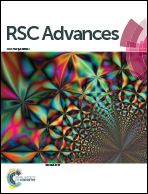Intercalation behavior and orientation structure of graphene oxide/polyethylene glycol hybrid material
Abstract
A series of graphene oxide/polyethylene glycol (GO/PEG) hybrid materials with different PEG molecular weights and contents were prepared, and the intercalation behavior and orientation structure were studied. It was found that compared with the XRD pattern of GO, the diffraction peaks of the GO/PEG hybrids shifted to lower angles due to the existence of PEG. With the increase of the molecular weight of PEG, the interlayer spacing of the hybrids first increased, reaching the maximum for the GO/PEG-20 000 hybrid, and then decreased. A similar variation trend can be observed for the hybrids with different PEG-20 000 contents, and the interlayer spacing and intercalation ratio reached the maximum for GO/80 PEG-20 000 sample. Remarkable red-shift of the O–H stretching vibration suggested the existence of hydrogen bonding interactions between the PEG-20 000 molecules and GO layers, leading to the enhancement of the thermal stability of GO. The intercalated PEG-20 000 molecules took a trans conformation and adopted an orderly structure of a monolayer arrangement as zigzag chains in the confined GO layers, while the skeletal structure of GO can be kept in the hybrids after intercalation. AFM and TEM analysis showed that the edges of GO/PEG-20 000 hybrids wrinkled more seriously than that of GO, and the maximum increased interlayer spacing (Δd) was approximately 0.4–0.5 nm, which agreed well with the XRD result.


 Please wait while we load your content...
Please wait while we load your content...